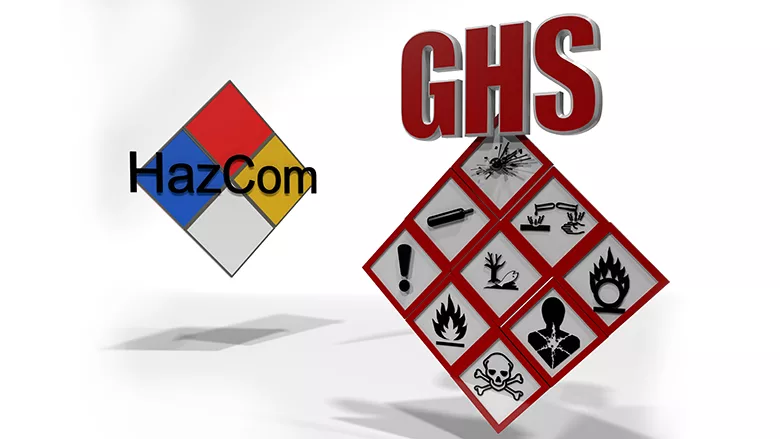HazCom and Drill Crews: Developing an Employer Program
Tips to Make Sense of Labeling, SDSs and Training for Toxic Substances

OHSA adoption of the Globally Harmonized System standardized the symbols and processes of HazCom for employees, wherever they work or the materials they work with originate from.
Source: Getty Images
In this article, I’d like to talk about how to develop an effective hazard communication program. The Occupational Safety and Health Administration’s hazard communication standard (HazCom), 29 CFR 1910.1200, requires the implementation of a HazCom program for each employer whose employees may receive exposure to hazardous chemicals. This program must include:
- Labeling of containers
- Safety data sheets
- And training for workers
Each employer must also have a written program that describes how it will meet the requirements of the HazCom standard.
Following any standard or regulation requires us to know and follow what’s in that standard or regulation. This link to the HazCom standard spells it all out so you can review its requirements. After reviewing the standard, we must decide whether OSHA would require our business to have a written HazCom program. The answer lies in what we have our employees do during the course of their work. Are we asking them to use any chemical or substance that could cause them harm if mishandled? A water wall contractor typically answers, “Yes.” We chlorinate wells and use various well rehab chemicals.
Why is HazCom so important? According to OSHA:
- 32 million workers work with and receive potential exposure to one or more chemical hazards during the course of their workday.
- There are roughly 650,000 chemicals used commercially.
- Approximately 50,000 workers die each year in the U.S. from occupational diseases.
- There are 52 known occupational diseases caused by chemical and biological agent exposure according to NIOSH (May 2017).
HazCom gave employees the right to know about the chemicals they use in their jobs. In 2012 OSHA adopted the United Nations’ Globally Harmonized System of Classification and Labeling of Chemicals (GHS). This standardization allows workers to easily understand the hazards of the chemicals they work with, regardless of where the chemicals originated or the work gets performed.
To ensure an effective hazard communication program and address necessary components, I recommend assigning responsibility for implementation and coordination to one individual. A written program details an employer’s procedures for meeting the requirements of this standard. Employees have the right to review the HazCom program during work hours on the jobsite. Employers must make the written program available to an employee or, if applicable, their representative on request, as well as OSHA.
The written program must:
- List the hazardous chemicals on jobsite.
- Explain how the employer will inform workers of hazards associated with non-routine tasks involving chemicals.
- Explain labels and other forms of warning used by the employer.
- Explain how the employer will provide safety data sheets (SDSs) to workers.
- Describe the training the employer uses to teach workers about hazardous chemicals.
In cases with more than one employer at a job site, the written HazCom program must also:
- Explain how SDSs will be provided to other employers.
- List the methods employers will use to inform other employers of measures taken to protect workers in foreseeable emergencies during normal operating conditions.
- Explain how employers will inform other employers of labeling systems used.
These things may seem mundane. However, failure to properly implement and maintain a hazard communication program consistently ranks in the top 10 for OSHA violations. (It sat at Number 2 from 2011-2015, but as of 2021 had fallen to the fifth-most-cited violation.) Many HazCom citations stem from failure to properly train your workforce. Employees must be trained on:
- How to detect the release of chemical hazards in the work area.
- The physical and health hazards of other substances they work with.
- Protective measures.
- The details, locations and availability of the written HazCom program and safety data sheets for each chemical they're working with.
- And their rights under the HazCom standard.
Anyone hired since 2012 should also get training on the elements of the Globally Harmonized System, SDS sections, general hazard categories, manufacturers’ labeling systems and whatever labeling system the contractor has decided to use in their HazCom program. Labeling may seem straightforward, but not many people realize that even temporary containers must carry labels unless all of the material in the container gets used immediately by the person who filled the container.
These things may seem mundane. However, failure to properly implement and maintain a hazard communication program consistently ranks in the top 10 for OSHA violations.
The final pieces in any effective program are evaluation and reassessment of the effectiveness. Periodically review your hazard communication program to make sure it meet objectives. Revise it to address any changes in condition, or new hazards or situations. Did your workplace introduce a new chemical or process? After updating written materials to incorporate the new information, ensure training on the updates for your workers.
As with many other regulations we must follow, OSHA has a guide to assist us. Refer to the “Hazard Communication Small Entity Compliance Guide For Employers That Use Hazardous Chemicals.” I hope this article has helped you understand how to improve your hazard communication and the links provided give you the tools to develop a quality program that will keep your employees healthy today, and for the future.
Until next month, keep turning to the right.Looking for a reprint of this article?
From high-res PDFs to custom plaques, order your copy today!



